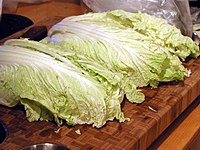Napa cabbage
| Napa cabbage | |
|---|---|
 |
|
| Species | Brassica rapa |
| Cultivar group | Pekinensis Group |
| Origin | China, before the 15th century |
| Napa cabbage | |||||||||||||||

Napa cabbage
|
|||||||||||||||
| Chinese name | |||||||||||||||
|---|---|---|---|---|---|---|---|---|---|---|---|---|---|---|---|
| Traditional Chinese | 大白菜 | ||||||||||||||
| Simplified Chinese | 大白菜 | ||||||||||||||
|
|||||||||||||||
| Cantonese name | |||||||||||||||
| Chinese | |||||||||||||||
|
|||||||||||||||
| Wu Chinese name | |||||||||||||||
| Chinese | |||||||||||||||
|
|||||||||||||||
| Korean name | |||||||||||||||
| Hangul | 배추 | ||||||||||||||
|
|||||||||||||||
| Japanese name | |||||||||||||||
| Kanji | 白菜 | ||||||||||||||
| Hiragana | はくさい | ||||||||||||||
|
|||||||||||||||
| Transcriptions | |
|---|---|
| Standard Mandarin | |
| Hanyu Pinyin | dà bái cài |
| Yue: Cantonese | |
| Jyutping | daai baak coi |
| Southern Min | |
| Hokkien POJ | bae cai |
| Transcriptions | |
|---|---|
| Yue: Cantonese | |
| Jyutping | wong4 ngaa4 baak6 |
| Transcriptions | |
|---|---|
| Wu | |
| Romanization | wang nga tsae |
| Transcriptions | |
|---|---|
| Revised Romanization | Baechu |
| McCune–Reischauer | Paech'u |
| Transcriptions | |
|---|---|
| Revised Hepburn | hakusai |
| Kunrei-shiki | hakusai |
| Nutritional value per 100 g (3.5 oz) | |
|---|---|
| Energy | 68 kJ (16 kcal) |
|
3.2 g
|
|
| Dietary fiber | 1.2 g |
|
0.2 g
|
|
|
1.2 g
|
|
| Vitamins | |
| Vitamin C |
(33%)
27 mg |
| Minerals | |
| Calcium |
(8%)
77 mg |
| Iron |
(2%)
0.31 mg |
| Magnesium |
(4%)
13 mg |
| Sodium |
(1%)
9 mg |
|
|
| Percentages are roughly approximated using US recommendations for adults. Source: USDA Nutrient Database |
|
Napa or nappa cabbage (Brassica rapa subsp. pekinensis or Brassica rapa Pekinensis Group) is a type of Chinese cabbage originating near the Beijing region of China, and is widely used in East Asian cuisine. Since the 20th Century it is also a widespread crop in Europe, America and Australia. In much of the world, this is the vegetable referred to as "Chinese cabbage".
The name "napa" comes from colloquial and regional Japanese, where nappa (菜っ葉?) refers to the leaves of any vegetable, especially when used as food. The Japanese name for this specific variety of cabbage is hakusai (白菜?)—literally "white vegetable"—a Sino-Japanese reading of the Chinese name. The Korean name for napa cabbage is baechu (Hangul: 배추).
Outside of Asia, this vegetable is also referred to as Chinese cabbage.
Regionally, it is also known as sui choy, and celery cabbage. In the United Kingdom this vegetable is known as Chinese leaf, in New Zealand as wong bok or won bok, and in the Philippines as wombok or pechay baguio. The name wombok is also used in Australia. Another name used in English is petsai or pe-tsai.
Napa cabbage is a cool season annual vegetable which grows best when the days are short and mild. The plant grows to an oblong shaped head consisting of tightly arranged crinkly, thick, light-green leaves with white prominent veins. Innermost layer leaves feature light yellow color.
Napa cabbage belongs to the family of Brassicaceae (Cruciferae, cabbage family), the Genus of Brassica and the subspecies pekinensis. As a cruciferous plant (Brassicaceae) it is closely related to species like broccoli, pak choi or cauliflower.
...
Wikipedia
